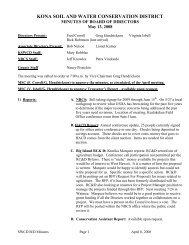2012 Annual Report - Kona Soil and Water Conservation District
2012 Annual Report - Kona Soil and Water Conservation District
2012 Annual Report - Kona Soil and Water Conservation District
Create successful ePaper yourself
Turn your PDF publications into a flip-book with our unique Google optimized e-Paper software.
Biological Control of Madagascar fireweed (Senecio madagascariensis); a New<br />
Tool in Integrated Control<br />
Hawaii Department of Agriculture<br />
Plant Pest Control Branch<br />
submitted by: Pat Conant (Entomologist Hilo ) Robert .T. Curtiss ( Entomologist <strong>Kona</strong>) <strong>and</strong> Darcy Oishi ( Acting Plant<br />
Pest Control Branch Manager)<br />
A heavy fireweed infestaon (> 30% cover) on rangel<strong>and</strong><br />
in the Saddle Road area of the isl<strong>and</strong> of Hawai‘i.<br />
Photo Source: 2005 CTAHR PUB PRM—1, Fireweed Control:<br />
An Adapve Management Approach<br />
Fireweed flowers profusely, <strong>and</strong> each flower can<br />
produce up to 150 seeds, which are easily dispersed by wind.<br />
Photo Source: 2005 CTAHR PUB PRM—1, Fireweed Control: An<br />
Adapve Management Approach<br />
Fireweed is a common name used for several unrelated<br />
plants found around the world. Since the early<br />
1980’s (Thorne et al 2005), Senecio madagascarienesis,<br />
or Madagascar fireweed, has become well established<br />
in Hawaii. Fireweed is suspected to have<br />
come to Hawaii in contaminated “hydromulch”<br />
from Australia that was sprayed on bare soil road<br />
cuts. However, on the Big Isl<strong>and</strong>, where it first<br />
showed up near Hawi in Kohala, the route of introduction<br />
is unknown. Fireweed is widespread <strong>and</strong> invasive<br />
now on Hawaii <strong>and</strong> Maui rangel<strong>and</strong>, vacant<br />
property, <strong>and</strong> native plant communities. Populations<br />
previously under control on Molokai <strong>and</strong> Lanai have<br />
undergone resurgence with recent rains. The Hawaii<br />
Department of Agriculture (HDOA) has mostly<br />
eradicated it at one site in SW Kauai after many<br />
years of h<strong>and</strong> removal. It is being contained at<br />
Schofield Barracks training area <strong>and</strong> is targeted for<br />
eradication by DPW Environmental Division staff.<br />
Pocket infestations are known to exist on Kahoolawe<br />
<strong>and</strong> are dealt with through manual control. The estimate<br />
of infested rangel<strong>and</strong> statewide is ~800,000<br />
acres. Herbicides have been used on a small scale,<br />
but on large rangel<strong>and</strong> areas, herbicide use is neither<br />
practical nor feasible in the long run. Lengthy<br />
droughts exacerbate the problem when forage dies<br />
back exposing bare soil to create a favorable habitat<br />
for fireweed when the rains come.<br />
Fireweed not only competes with rangel<strong>and</strong> forage<br />
plants, but it is also toxic to livestock. There are several<br />
sub-lethal effects of consumption, but it will<br />
eventually kill horses <strong>and</strong> cattle by harming the liver.<br />
Although sheep are much more tolerant <strong>and</strong> can<br />
even be used to control it, it will harm them if they<br />
eat enough of it.<br />
Chemical <strong>and</strong> cultural controls are not enough to protect rangel<strong>and</strong> from this scourge. The HDOA began<br />
a biological control program in the weeds native range of Southern Africa <strong>and</strong> Madagascar. The HDOA<br />
Exploratory Entomologist, Dr. Mohsen Ramadan, traveled to both areas beginning in 1999 <strong>and</strong> collected<br />
potential natural enemies for testing in the insect containment facility in Honolulu. He found leaf feeders,<br />
flower feeders, root feeders, <strong>and</strong> stem boring insects in addition to two rust diseases. One natural enemy,<br />
a moth (Secusio extensa), in particular showed promise <strong>and</strong> was easy to rear in quarantine.<br />
6





